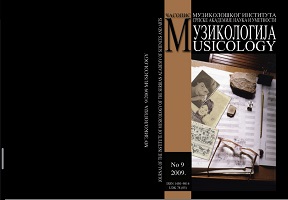Атина – нова престоница традиционалне грчке музике (Сведочанства о музичком животу с почетка XX века)
New Capital of Traditional Greek Music (Testimonies On Musical Life at the Beginning of the Twentieth Century
Author(s): Vesna Sara PenoSubject(s): Music, Cultural Anthropology / Ethnology, Sociology of Art, History of Art
Published by: Muzikološki institut SANU
Keywords: Athens; Constantinople; Europe; Greek; Byzantine chant; polyphonic music; magazine; Formigs; pedagogy; national;
Summary/Abstract: During its long Byzantine and Post-Byzantine history Constantinople was the center for church art in general, but especially for music. This old city on the Bosporus maintained its prime position until the beginning of the 20th century when, because of new political and social conditions, the Greek people started to acquire their independence and freedom, and Athens became the new capital in the cultural as well as the political sense. During the first decades of the 20th century the Athenian music scene was marked by an intensive dispute between those musicians who leaned towards the European musical heritage and its methods in musical pedagogy, and those who called themselves traditionalists and were engaged in the preservation of traditional values of church and folk music. The best insight into the circumstances in which Greek musical life was getting a new direction are offered by the numerous musical journals published in Athens before the First World War. Among them, The Formigs is of the special interest, firstly because of the long period during which it was published (1901–1912), and secondly because of its main orientation. The editor Ioannes Tsoklis, a church chanter, and his main collaborator, the famous Constantinopolitan musician and theorist and later Principal of the Department for Byzantine music at Athens musical school Konstantinos Psahos, with other associates, firmly represented the traditional position. That is why most of the published articles and the orientation of the journal generally were dedicated to the controversial problems and current musical events that were attracting public attention. The editorial board believed that there was a conection between the preservation of musical traditions and their development on one side, and foreign musical influences that were evident in the promotion of polyphonic church music, which had been totally foreign to the Greek Orthodox church until the end of the 19th century, on the other. Tsoklis and Psahos were resolved to provide enough reliable documented articles and theoretical and historical studies on church and folk music to pull up the church chanters and in such a way contribute to their better musical education. They assured that this would be the best way to attract and recruit church chanters struggling to maintain their own musical heredity. The Formigs thus served primarily in the socalled Greek music question, actuated with the aim of eliminating polyphonic music from liturgical practice. However, it also assisted in national endeavors to ensure that church and folk music would obtain separate status in official Greek musical education, which had been significantly changed by non-traditional, European methodology.
Journal: Muzikologija
- Issue Year: 1/2009
- Issue No: 9
- Page Range: 15-32
- Page Count: 18
- Language: Serbian

